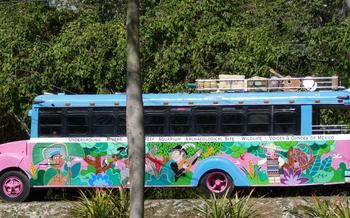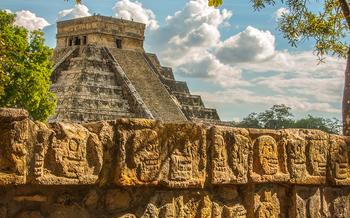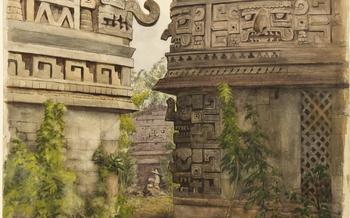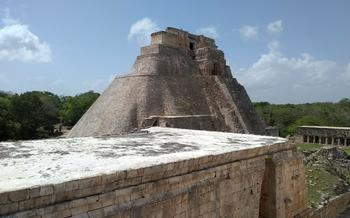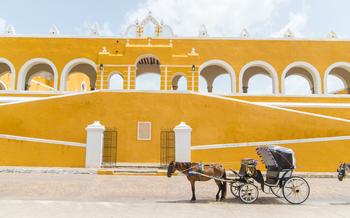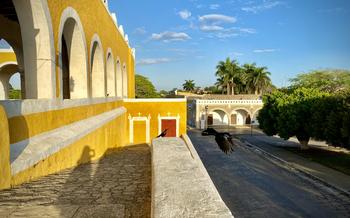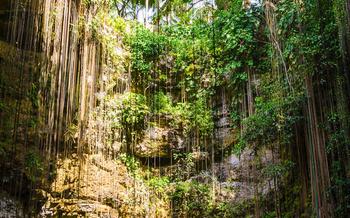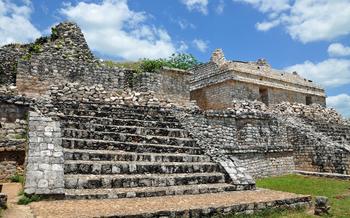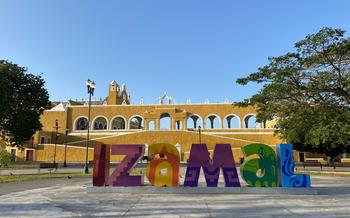
Ek Balam (Nearby city)
- Ek Balam: An Ancient Maya City in the Yucatán Peninsula
- The Acropolis of Ek Balam
- The Oval Palace
- The Juego de Pelota (Ball Court)
- The Cenote X'canche
- The Stelae of Ek Balam
- The East Acropolis
- The Museum of Ek Balam
- Guided Tours
- Photography Tips
- Wildlife Spotting
- Dress and Comfort
- Food and Drinks
- Souvenirs
- Insider Tip: Unveiling Ek Balam's Hidden Secrets
Ek Balam: An Ancient Maya City in the Yucatán Peninsula
In the heart of the Yucatán Peninsula, just a short journey from the vibrant city of Izamal, lies the ancient Maya city of Ek Balam, a marvel that has stood the test of time. Ek Balam, meaning "Black Jaguar" or "Jaguar Star," was once a thriving metropolis, a cultural epicenter, and a testament to the ingenuity and artistry of the ancient Maya civilization.
This well-preserved archaeological site allures travelers with its impressive structures, intricate carvings, and captivating history. Immerse yourself in the grandeur of the ancient Maya world as you explore the ruins of Ek Balam, revealing secrets of a civilization that continues to inspire awe and wonder. Its proximity to Izamal makes it an ideal day trip, offering a glimpse into the rich cultural heritage of the Yucatán.
The Acropolis of Ek Balam
The Acropolis of Ek Balam is the heart of the ancient city, where the ruling elite resided and conducted important ceremonies. Dominating the skyline is the main pyramid, a towering structure that offers breathtaking views from its summit. Visitors can climb the steep steps to reach the top, where they are rewarded with panoramic vistas of the surrounding jungle and the archaeological site.
The Acropolis also features other notable structures, including the North Acropolis Palace, the South Acropolis Palace, and the Temple of the Oval Palace. These buildings showcase intricate carvings, stucco decorations, and hieroglyphs that provide glimpses into the lives and beliefs of the Maya people.
One of the most striking features of the Acropolis is the large platform known as the Acropolis Plaza. This open space was likely used for public gatherings, ceremonies, and rituals. Visitors can wander through the Acropolis Plaza, admiring the impressive architecture and imagining the vibrant life that once took place here.
The Oval Palace
Among the impressive structures of Ek Balam, the Oval Palace stands out for its unique shape and intriguing purpose. This elongated building, constructed on a raised platform, is believed to have served as the residence of the city's rulers and their families. The palace derives its name from its distinctive oval shape, a rare feature in Maya architecture.
The exterior of the Oval Palace is adorned with intricate stucco decorations and hieroglyphs, providing valuable insights into the history and culture of Ek Balam. The intricate carvings depict various scenes, including the life of the ruling elite, religious ceremonies, and important historical events. The palace's interior features several rooms, each with its own unique function and decorations, offering a glimpse into the daily lives of the city's rulers.
The Oval Palace holds a special significance in understanding the social and political structure of Ek Balam. Its elaborate design and decorations reflect the power and prestige of the ruling elite, who played a crucial role in governing the city and maintaining its cultural and economic prosperity.
The Juego de Pelota (Ball Court)
The Juego de Pelota, or ball court, is a prominent feature of the Ek Balam archaeological site. It holds immense cultural and historical significance, as the ball game played here was a central part of Maya civilization. Measuring approximately 50 meters in length and 30 meters in width, the court exhibits the classic layout seen in many Maya cities. The sloping sides of the court are lined with stone benches, allowing spectators to witness the intense matches.
The ball court at Ek Balam is particularly notable for its well-preserved carvings and sculptures, which depict various aspects of the game. These carvings showcase players in action, demonstrating their athleticism and skill. They also illustrate the significance of the game in Maya society, as it was believed to have both religious and political implications.
Visitors to Ek Balam can marvel at the intricate carvings adorning the ball court. These carvings provide valuable insights into the symbolism and rituals associated with the game. The ball court stands as a testament to the cultural and sporting prowess of the ancient Maya civilization.
The Cenote X'canche
The Cenote X'canche is a natural wonder located within the Ek Balam archaeological site. This cenote is a sinkhole filled with crystal-clear water, surrounded by lush vegetation and towering limestone walls. The cenote's depth reaches approximately 20 meters, making it an ideal spot for swimming and cooling off on a hot day.
Natural Beauty and Swimming Opportunities: The Cenote X'canche is a breathtaking sight, with its turquoise waters contrasting against the vibrant green surroundings. Visitors can swim in the cenote's refreshing waters, dive to explore its depths, or simply relax on the rocky ledges and soak in the natural beauty. The cenote is a popular spot for swimming, snorkeling, and diving, offering a unique and refreshing experience.
Ritual Significance of Cenotes in Maya Culture: Cenotes were sacred places for the ancient Maya, and X'canche was likely used for ceremonial purposes. The Maya believed that cenotes were portals to the underworld and were associated with the rain god, Chaac. Offerings and sacrifices were often made in cenotes to appease the gods and ensure a good harvest. The Cenote X'canche may have been used for similar rituals, connecting the Maya to the divine realm.
The Stelae of Ek Balam
The ancient city of Ek Balam is home to a collection of stelae, which are carved stone monuments that served various purposes in Maya culture. These stelae are strategically placed throughout the site, often in prominent locations such as plazas or near significant structures.
One of the most notable stelae is known as Stela 1, which depicts a ruler named Ukit Kan Lek Tok'. The stela showcases intricate carvings and hieroglyphs that provide valuable insights into the history and lineage of the Ek Balam dynasty.
Another significant stela, Stela 2, portrays a different ruler named Chan Ahkat Tok'. This stela is particularly interesting as it features a detailed narrative, recounting a significant event or achievement in the ruler's reign. The carvings depict a battle scene, with warriors engaged in combat.
The stelae at Ek Balam offer a glimpse into the lives and accomplishments of the city's rulers. They provide valuable historical information, helping to piece together the story of Ek Balam's rise and fall. Furthermore, the intricate carvings and hieroglyphs on these monuments showcase the artistic and cultural achievements of the ancient Maya civilization.
The East Acropolis
While smaller in scale compared to the main acropolis, the East Acropolis of Ek Balam holds its own significance and charm. This complex of structures is located on the eastern side of the site and offers a unique perspective of the ancient city.
One of the notable buildings within the East Acropolis is the Temple of the Twins, which features two identical chambers with elaborate stucco decorations and hieroglyphs. The temple is believed to have been dedicated to the Maya rain gods and was likely used for rituals related to water and agriculture.
Other structures within the East Acropolis include the Temple of the Masks, named for the carved stone masks that adorn its facade, and the Temple of the Serpent, which is decorated with serpent motifs. These temples provide further insights into the religious and cultural practices of the ancient Maya.
From the East Acropolis, visitors can enjoy panoramic views of the surrounding landscape, including the lush jungle and the distant ruins of the main acropolis. This vantage point offers a unique opportunity to appreciate the scale and grandeur of Ek Balam and to immerse oneself in the natural beauty that surrounds the ancient city.
The Museum of Ek Balam
Within the archaeological site of Ek Balam, visitors can find a small but informative museum dedicated to showcasing the history and culture of the ancient city. The museum is conveniently located near the entrance of the site, making it an excellent starting point for your exploration.
Exhibits and Artifacts
The museum houses a collection of artifacts and exhibits that provide insights into the daily lives, rituals, and beliefs of the Maya people who once inhabited Ek Balam. Visitors can admire intricate pottery, stone tools, and jewelry that speak to the artistry and craftsmanship of the Maya. Informative panels and displays accompany the exhibits, providing historical context and explanations.
Educational Opportunities
The Museum of Ek Balam offers an excellent opportunity for visitors to learn more about the fascinating history of the site and the Maya civilization as a whole. Whether you're a history buff, an archaeology enthusiast, or simply curious about the ancient world, the museum provides a wealth of knowledge and insights.
Interactive Displays
To enhance the visitor experience, the museum incorporates interactive displays that bring the past to life. Visitors can engage with touchscreens, listen to audio guides, and even participate in hands-on activities that provide a deeper understanding of Maya culture. These interactive elements make the museum particularly appealing to families with children.
Guided Tours
Exploring Ek Balam with a knowledgeable guide is highly recommended. These guides are passionate about the history and culture of the Maya and can provide valuable insights into the significance of the site. They will point out hidden details, explain the symbolism behind the carvings, and bring the ancient city to life with their storytelling.
Guided tours typically cover the main highlights of Ek Balam, including the Acropolis, the Oval Palace, the Juego de Pelota, and the Cenote X'canche. Guides will provide historical context, explain the functions of different structures, and answer any questions you may have.
Booking a guided tour is easy and can be done through local tour operators or online platforms. Tours are available in various languages, ensuring that visitors from different backgrounds can enjoy the experience.
The cost of a guided tour varies depending on the duration, group size, and inclusions. However, the investment is worth it, as it enhances the overall understanding and appreciation of Ek Balam.
Photography Tips
Capturing the essence of Ek Balam through photography requires careful consideration of lighting, composition, and subject matter. The best time to visit for optimal lighting is early morning or late afternoon, when the sun's rays cast dramatic shadows and enhance the textures of the ancient structures. Wide-angle lenses are ideal for capturing the grand scale of the pyramids and the surrounding landscape, while telephoto lenses allow for close-up shots of intricate carvings and details. Experiment with different angles and perspectives to create dynamic compositions that convey the majesty and mystery of Ek Balam. Don't forget to include the lush vegetation and wildlife that add vibrance and life to the archaeological site. Remember to respect the site regulations regarding photography, particularly the use of flash and tripods, to preserve the integrity of the ancient ruins.
Wildlife Spotting
Ek Balam is not just a place of historical importance but also a haven for wildlife enthusiasts. The lush vegetation and diverse ecosystems within the site attract a variety of animal species. Birdwatching is a popular activity, with over 150 species recorded in the area. Keep an eye out for colorful birds like the Yucatan jay, the vermilion flycatcher, and the toucan. Other wildlife commonly seen includes iguanas, coatimundis, spider monkeys, and even the occasional tapir.
Wildlife photography is another popular pursuit at Ek Balam. The abundance of birds and other animals provides ample opportunities to capture stunning shots. Remember to be respectful of the wildlife and maintain a safe distance. The natural environment is delicate, so always avoid disturbing the animals or their habitats.
Dress and Comfort
Dress appropriately: Ek Balam is located in a tropical climate, so it's important to dress accordingly. Wear light, loose-fitting clothing made from natural fibers like cotton or linen. Avoid wearing synthetic materials, as they can trap heat and make you feel uncomfortable.
Comfortable footwear: You'll be doing a lot of walking on uneven terrain, so comfortable footwear is essential. Opt for closed-toe shoes with good arch support, such as hiking boots or sneakers. Avoid wearing sandals or flip-flops, as they can easily slip off or get damaged on the rough ground.
Protect yourself from the sun: The sun can be intense in Ek Balam, so it's important to protect yourself from its harmful rays. Wear a hat, sunglasses, and sunscreen with an SPF of 30 or higher. Reapply sunscreen frequently, especially after swimming or sweating.
Stay hydrated: It's easy to get dehydrated in the hot and humid climate of Ek Balam, so make sure to drink plenty of water throughout your visit. Bring a reusable water bottle and fill it up at the cenote or at one of the water stations in the archaeological park.
Pack insect repellent: Insects, such as mosquitoes, are common in Ek Balam, especially during the rainy season. Pack insect repellent and apply it liberally to your skin and clothing. You may also want to wear long sleeves and pants to minimize exposed skin.
Food and Drinks
Ek Balam offers a range of dining options for visitors to refuel and rehydrate during their exploration. There are several small restaurants and cafes located within the archaeological site, serving a variety of local dishes and drinks. Visitors can enjoy traditional Yucatecan cuisine, such as cochinita pibil (slow-roasted pork), panuchos (fried tortillas with beans and meat), and salbutes (toasted tortillas with shredded turkey or chicken). Fresh fruit juices, bottled water, and soft drinks are also available.
For those who prefer a more private dining experience, it is possible to bring a picnic lunch to enjoy within the site. There are designated picnic areas with tables and benches where visitors can relax and enjoy their meal surrounded by the ancient ruins. It is important to remember to pack all necessary utensils, plates, and napkins, as well as any necessary food containers or coolers.
Staying hydrated is essential when visiting Ek Balam, especially during the hot and humid months. Visitors should bring their own water bottles or purchase them from the vendors within the site. It is also important to wear light and breathable clothing, as well as sunscreen and a hat to protect from the sun's rays.
Souvenirs
At Ek Balam, you'll find a variety of souvenirs to take home as mementos of your visit. These souvenirs not only serve as keepsakes but also support the local artisans and the community. From intricate Mayan-inspired jewelry to hand-woven textiles, there's something for every taste and budget.
Be sure to visit the souvenir shops located near the entrance of the archaeological site. Here, you'll find a wide selection of authentic handicrafts, including colorful hammocks, pottery, and wood carvings. Haggling is not only acceptable but expected, so don't be afraid to negotiate a fair price.
In addition to the souvenir shops, you may also encounter local vendors selling their wares along the paths leading to the different structures. These vendors often offer unique items that you won't find in the shops, such as handmade dolls, dreamcatchers, and traditional Mayan clothing.
When shopping for souvenirs at Ek Balam, remember to be respectful of the local culture and economy. By purchasing from local artisans, you not only get a piece of Mayan history and culture but also contribute to the community's livelihood.
Insider Tip: Unveiling Ek Balam's Hidden Secrets
Explore the Residential Areas: Venture beyond the main attractions and discover the residential areas of Ek Balam. These areas offer a glimpse into the daily lives of the ancient Maya, with remnants of houses, workshops, and kitchens providing insights into their domestic architecture and lifestyle.
Seek Out the Hieroglyphic Staircase: Ascend the Hieroglyphic Staircase, a hidden gem tucked away within the site. Adorned with intricate carvings and inscriptions, this staircase narrates the history and lineage of Ek Balam's rulers, offering a unique perspective on Maya history and culture.
Witness the Sunset at the East Acropolis: Experience the magic of Ek Balam at sunset by climbing to the East Acropolis. As the sun dips below the horizon, the surrounding landscape transforms into a canvas of vibrant colors, creating a breathtaking spectacle.
Visit the Cenote Maya: While Ek Balam is renowned for its cenote X'canche, there's another lesser-known cenote called Cenote Maya located nearby. Surrounded by lush vegetation, this hidden gem offers a serene and refreshing oasis for swimming and relaxation.
Engage with the Local Community: Take the opportunity to interact with the local Mayan community who reside near Ek Balam. Learn about their traditions, customs, and way of life, gaining a deeper understanding of the region's cultural heritage.
